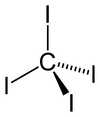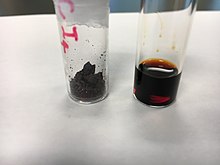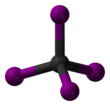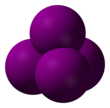Carbon tetraiodide

| |||

| |||
| |||
| Names | |||
|---|---|---|---|
| Preferred IUPAC name
Tetraiodomethane[1] | |||
| Identifiers | |||
3D model (JSmol)
|
|||
| 1733108 | |||
| ChemSpider | |||
| ECHA InfoCard | 100.007.335 | ||
| EC Number |
| ||
PubChem CID
|
|||
| RTECS number |
| ||
| UNII | |||
CompTox Dashboard (EPA)
|
|||
| Properties | |||
| CI4 | |||
| Molar mass | 519.629 g·mol−1 | ||
| Appearance | Dark violet crystals | ||
| Density | 4.32 g mL−1 | ||
| -136·10−6 cm3/mol | |||
| Structure | |||
| Tetragonal | |||
| Tetrahedral | |||
Dipole moment
|
0 D | ||
| Thermochemistry | |||
Heat capacity (C)
|
0.500 J K−1 g−1 | ||
Std enthalpy of
formation (ΔfH⦵298) |
384.0–400.4 kJ mol−1 | ||
Std enthalpy of
combustion (ΔcH⦵298) |
−794.4–−778.4 kJ mol−1 | ||
| Hazards | |||
| GHS pictograms | 
| ||
| GHS Signal word | Warning | ||
GHS hazard statements
|
H315, H319, H335 | ||
| P261, P305+351+338 | |||
| Related compounds | |||
Related alkanes
|
| ||
Related compounds
|
|||
Except where otherwise noted, data are given for materials in their standard state (at 25 °C [77 °F], 100 kPa). | |||
| Infobox references | |||
Carbon tetraiodide is a tetrahalomethane with the molecular formula CI4. Being bright red, it is a relatively rare example of a highly colored methane derivative. It is only 2% by weight carbon, although other methane derivatives are known with still less carbon.[citation needed]
Structure[]
The tetrahedral molecule features C-I distances of 2.12 ± 0.02 Å.[2] The molecule is slightly crowded with short contacts between iodine atoms of 3.459 ± 0.03 Å, and possibly for this reason, it is thermally and photochemically unstable.
Carbon tetraiodide crystallizes in tetragonal crystal structure (a 6.409, c 9.558 (.10−1 nm)).[3]
It has zero dipole moment due to its symmetrically substituted tetrahedral molecule.
Properties, synthesis, uses[]
Carbon tetraiodide is slightly reactive towards water, giving iodoform and I2. It is soluble in nonpolar organic solvents. It decomposes thermally and photochemically to , C2I4. Its synthesis entails AlCl3-catalyzed halide exchange, which is conducted at room temperature:[4]
The product crystallizes from the reaction solution.
Carbon tetraiodide is used as an iodination reagent, often upon reaction with bases.[5] Ketones are converted to 1,1-diiodoalkenes upon treatment with triphenylphosphine (PPh3) and carbon tetraiodide. Alcohols are converted in and to iodide, by a mechanism similar to the Appel reaction. In an Appel reaction, carbon tetrachloride is used to generate alkyl chlorides from alcohols.
Safety considerations[]
Manufacturers recommend that carbon tetraiodide be stored near 0 °C (32 °F). As a ready source of iodine, it is an irritant. Its LD50 is 178 mg.kg−1. In general, perhalogenated organic compounds should be considered toxic, with the narrow exception of small perfluoroalkanes (essentially inert due to the strength of the C-F bond).
References[]
- ^ "Tetraiodomethane - Compound Summary". PubChem Compound. USA: National Center for Biotechnology Information. 27 March 2005. Identification and Related Records. Retrieved 29 February 2012.
- ^ Finbak, Chr.; Hassel, O. (1937). "Kristallstruktur und Molekülbau von CI4 und CBr4". Zeitschrift für Physikalische Chemie. B36: 301–308. doi:10.1515/zpch-1937-3621.
- ^ Pohl, S. (1982). "Die Kristallstruktur von CI4". Zeitschrift für Kristallographie. 159: 211–216. doi:10.1524/zkri.1982.159.14.211.
- ^ McArthur, R. E.; Simons, J. H. (1950). "Carbon Tetraiodide". Inorganic Syntheses. III: 37–39. doi:10.1002/9780470132340.ch8.
- ^ P. R. Schreiner, A. A. Fokin (2005). "Carbon Tetraiodide". In L. Paquette (ed.). Encyclopedia of Reagents for Organic Synthesis. John Wiley & Sons, Ltd.
Further reading[]
- Sorros H., Hinkam J. B. (1945). "The Redistribution Reaction. XI. Application to the Preparation of Carbon Tetraiodide and Related Halides". Journal of the American Chemical Society. 67: 1643. doi:10.1021/ja01226a004.
- Inorganic carbon compounds
- Nonmetal halides
- Iodoalkanes
- Halomethanes
- Reagents for organic chemistry



